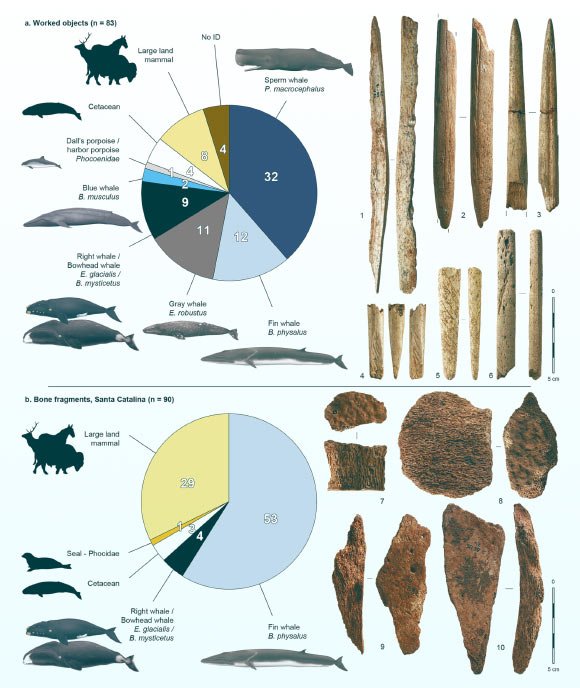Archaeologists have examined a large sample of worked bone objects from 26 Paleolithic cave and rockshelter sites in the Cantabrian region of Spain and southwestern France.

Taxonomic identification of the 173 worked (a) and unworked (b) bone objects: (1) blank, Tito Bustillo, sperm whale; (2) projectile point with massive base, Isturitz, blue whale; (3) projectile point, Brassempouy, fin whale; (4) possible foreshaft, Las Caldas, sperm whale; (5) projectile point with massive base, Ermittia, gray whale; (6) unidentified object, Saint-Michel, sperm whale; (7-10) unworked fragments of fin whale bone, Santa Catalina. Image credit: McGrath et al., doi: 10.1038/s41467-025-59486-8.
“Whales, the largest animals on Earth, were an important source of food and materials such as oil and bone,” said first author Dr. Krista McGrath, an archaeologist at the Universitat Autònoma de Barcelona, and colleagues.
“For this reason, they are believed to have played a key role in the survival of many coastal human groups.”
“However, tracing the origins of human-whale interactions is challenging, as coastal archaeological sites are especially fragile and vulnerable to rising sea levels, making it difficult to preserve evidence of early human-marine mammal relationships.”
In their research, the authors analyzed 83 bone tools from cave and rockshelter sites around the Bay of Biscay in Spain along with 90 additional bones from Santa Catalina Cave, also located in the province of Biscay.
They used mass spectrometry and radiocarbon dating to identify the species and age of the artifacts.
The two earliest dates were from the Cantabrian sites of Rascaño and El Juyo: 20,200-19,600 and 19,600-19,000 years, respectively.
“Our study reveals that the bones came from at least five species of large whales, the oldest of which date to approximately 19,000-20,000 years ago,” said senior author Dr. Jean-Marc Pétillon, an archaeologist at the Université Toulouse Jean Jaurès and CNRS.
“These represent some of the earliest known evidence of humans using whale remains as tools.”
“ZooMS is a powerful technique for investigating past sea mammal diversity, particularly when diagnostic morphometric elements are missing from bone remains and objects, which is often the case for bone artifacts,” Dr. McGrath said.
“We managed to identify species such as sperm whales, fin whales, blue whales, all still present in the Bay of Biscay today, as well as gray whales, a species now mostly restricted to the North Pacific and Arctic Oceans.”
“In addition, chemical data extracted from the bones suggest that the feeding habits of these ancient whales differed slightly from those of their modern counterparts, pointing to potential changes in behavior or the marine environment.”
“Overall, this discovery not only enhances our understanding of early human use of whale remains but also sheds light on the role whales played in past ecosystems.”
The team’s paper appears today in the journal Nature Communications.
_____
K. McGrath et al. 2025. Late Paleolithic whale bone tools reveal human and whale ecology in the Bay of Biscay. Nat Commun 16, 4646; doi: 10.1038/s41467-025-59486-8











